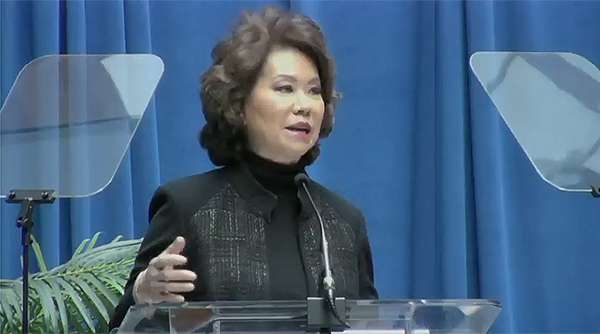Senior Reporter
Chao Tells Automated Vehicle Summit DOT “3.0” Guidance Could Be Issued in Early Summer

WASHINGTON — Updated federal guidance for manufacturers and states seeking to deploy self-driving vehicles could be released as early as summer, U.S. Transportation Secretary Elaine Chao told hundreds of executives attending the automated vehicle policy summit here.
The new policy, to be called AV 3.0, will specifically address automated policy guidance for trucks as well as cars, rail and mass transit, Chao told some 400 executives.
“As you may know, human error is a factor in 94% of highway accidents,” Chao said at the March 1 summit. “Autonomous technology can help improve safety across all modes of transportation, not just automobiles. But there are challenges, as well.”
Chao listed public concerns about the security and privacy of automated technology along with the potential for hacking.
“In January, AAA reported that 63% of U.S. drivers are afraid to ride in a fully autonomous vehicle,” Chao said. “That’s down from 78% reporting such fears in early 2017, but is still a majority.”
Chao said policy makers are also studying how new technologies may impact the workforce.
“New technologies create jobs, but the transition period can be very difficult for dislocated workers,” she said. “This needs to be addressed to help workers adapt to this new world.”
There is widespread interest in automated technology; Chao said that AV 2.0 — the current federal guidance issued in September of 2017— was the most-viewed DOT policy document posted on the agency’s website. “Since it was released, only six months ago, it has been downloaded more than 125,000 times,” Chao said.
The summit also included expert panelists from across transportation.
One day removed from being sworn in as administrator of the Federal Motor Carrier Safety Administration, Raymond Martinez said automated trucks could save “thousands and thousands of lives,” and also hold potential to benefit the economy.
“Automation can reduce congestion, which can improve productivity and lift the cost associated with crashes,” said Martinez, who most recently was the New Jersey Motor Vehicle Commission’s chairman and chief administrator. “When freight moves with more efficiency, it reduces the price of goods and stimulates economic growth.”
He added, “Of course, all revolutions come with costs and challenges.”
One of those challenges is the truck driver shortage and the perception that trucks will soon be driving themselves, said Chris Spear, CEO of American Trucking Associations.
“In the context of innovation we truly believe that autonomous technology can supplement some of this shortfall,” Spear said. “We aren’t, however, talking about it as driverless. We look at this issue through the lens of driver-assist technology.”
The Honorable Elaine L. Chao, Secretary of Transportation, delivering Keynote Address at the US Department of Transportation’s “Public Listening Summit on Automated Vehicle Policy” at DoT Headquarters @USDOT #AutonomousVehicles @SecElaineChao #LeadershipCommitment #CyberSecurity pic.twitter.com/YdJ4VwiAjv — Christina Ayiotis (@christinayiotis) March 1, 2018
“I am overtaken by the fact that so many folks — particularly the media — are so overcome by this shiny thing over here, that we’re going to be level 5 [autonomous] tomorrow and displace all 3.5 million drivers in our industry.”
Spear added, “The trucking industry is really impeded by this misnomer. ...We’re maybe decades away from talking about a driverless technology.”
Spear urged all transportation modes to listen, do homework, get out in the real world, and visit automated vehicle test sites and software developers.
Panel moderator Marjorie Dickman, associate general counsel at Intel Corp., said Intel estimates automated vehicles could save 500,000 lives between 2035 and 2045, when it projects that half of the vehicles on U.S. roads will have some level of automation.
Meantime, Dickman said consumers must learn to trust the new technology’s safety, the vehicles must be affordable, and governmental policies must prioritize safety but also remove barriers to innovation.
Steven Bradbury, DOT general counsel, said AV 3.0 will focus on all surface transportation modes.
Regulators should not attempt to “reinvent the wheel” with new regulations, but rather adapt current regulations to new innovations, he said.
“FMCSA rules are largely focused on addressing human driver training, issues of human driver fatigue, hours of service, rest and meal stops, etc.,” Bradbury said. “Many of these rules will need to be rethought, supplemented, as they may apply to automated vehicle systems or automated assistance for human drivers of motor carriers.”

